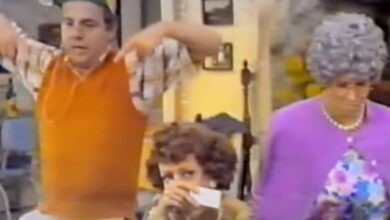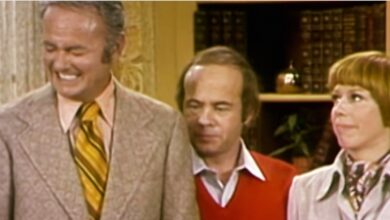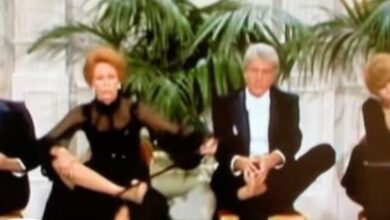Marty Robbins’ “El Paso” Transcended Country Boundaries and Redefined Narrative Songwriting in 1959
When Marty Robbins released “El Paso” in 1959, he didn’t just put another hit single into the jukeboxes of America—he told an epic western tale that would carve out a new frontier in country music. At a time when the genre was largely dominated by short, direct emotional ballads or upbeat honky-tonk numbers, “El Paso” arrived with cinematic ambition. The ballad, stretching over four minutes long—unusual for the era—defied conventional radio length restrictions and still reached No. 1 on both the country and pop charts. It was the first country song to win a Grammy Award, earning Robbins the Best Country & Western Recording in 1961, and it helped country music gain broader national and international visibility.
Born in Glendale, Arizona in 1925, Martin David Robinson grew up in the rugged terrain that would later flavor many of his most enduring songs. His early life was shaped by desert landscapes, rodeo tales, and the rugged mythos of the American Southwest. After serving in the U.S. Navy during World War II, he returned with a deep interest in music and began performing on local radio. What set Robbins apart was his smooth, crooning vocal tone, paired with a unique ability to blend country music with other genres—particularly folk, pop, and Latin influences. He became one of Columbia Records’ most versatile stars and remained relevant through shifting musical tides across three decades.
“El Paso” was born out of Robbins’ fascination with cowboy ballads and gunfighter tales—genres that had roots in 19th-century American folk music but hadn’t yet been brought to life in such vivid detail on record. He wrote the song himself, reportedly in a single sitting, inspired by classic western stories and possibly by personal memories from his Arizona upbringing. The lyrics followed a dramatic arc: a cowboy falls in love with a Mexican maiden named Felina, kills a rival in a jealous rage, flees town, and ultimately returns to El Paso to find her—only to die in her arms. Its tragic, romantic scope and poetic imagery gave listeners something far deeper than a standard country single—it gave them a story to live in.
The recording of “El Paso” was as ambitious as its narrative. Produced by Don Law, the track featured Grady Martin’s instantly recognizable Spanish-style guitar work, which would later become one of the most famous guitar accompaniments in country history. Robbins’ vocal performance was rich with pathos and precision, each verse unfolding like a chapter in a novel. The production embraced acoustic storytelling, but layered it with lush harmonies from The Glaser Brothers and Latin-influenced guitar lines that expanded the song’s sonic reach far beyond standard Nashville fare.
Upon release, “El Paso” became a commercial and critical phenomenon. It topped the Billboard Hot 100 in January 1960, making it one of the rare pure country songs to cross into the pop mainstream at the time. Radio DJs, initially hesitant about its length, found that audience demand was too strong to ignore. The song became a staple of jukeboxes across the country and stayed on the charts for an astonishing 22 weeks. Robbins’ Grammy win cemented its artistic merit, and its success helped elevate the credibility of country music in the eyes of a broader public.
“El Paso” didn’t just impact sales charts—it changed expectations for what a country song could be. It demonstrated that audiences were willing to engage with longer, more narrative-driven material, opening the door for future storytelling masterpieces across genres. In many ways, it prefigured the folk-rock movement of the 1960s, and Robbins’ success encouraged artists like Johnny Cash and Bob Dylan to delve deeper into story songs that blurred the lines between country, folk, and rock.
For Robbins, “El Paso” was a career-defining moment that opened new creative avenues. He would return to the story’s setting and characters in later works, recording two sequels: “Feleena (From El Paso)” in 1966, and “El Paso City” in 1976, both of which revisited the themes and expanded the mythos. The success of “El Paso” also allowed Robbins to continue exploring more experimental styles in albums that mixed gunfighter ballads, Hawaiian music, and even rockabilly—all while maintaining a loyal fan base.
The song’s influence spread far and wide. It helped revive interest in traditional narrative ballads and was cited by numerous artists—from Waylon Jennings to Willie Nelson—as a formative example of country storytelling. It also inspired more cinematic approaches to songwriting, where lyrics painted vivid scenes and invited listeners into entire worlds rather than just moments or emotions. Its fusion of Southwestern imagery and Spanish guitar influenced later works by Linda Ronstadt and the Eagles, while its structure became a reference point for aspiring writers across genres.
Over the years, “El Paso” has been covered by many artists, though few have attempted to match Robbins’ full storytelling arc. The Grateful Dead famously performed it live as part of their concert repertoire, giving it a psychedelic Americana twist. Other artists, like Tom Russell and The Milk Carton Kids, have paid tribute through reinterpretations or homage tracks, acknowledging its lasting impact on the Americana and outlaw country traditions.
Around the time of the song’s release, Robbins was experiencing a creative high and public acclaim. Though already known for hits like “A White Sport Coat (and a Pink Carnation),” it was “El Paso” that made him a household name and elevated his profile significantly. It also allowed him to expand beyond music—he became a NASCAR driver and a television personality in the years following, balancing his chart-topping hits with his passion for racing and showmanship.
Decades later, the legacy of “El Paso” continues to thrive. The song is a mainstay on classic country radio, and it frequently appears on “greatest country songs” lists from Rolling Stone to the Country Music Hall of Fame. Its influence can be felt not only in country but in narrative-driven music across the spectrum, from Springsteen to Sturgill Simpson. Even listeners unfamiliar with Robbins’ full discography can instantly recognize the song’s opening guitar riff and sweeping story.
“El Paso” helped lay the foundation for a generation of cross-genre experimentation. Its unexpected pop chart dominance and critical acclaim paved the way for songs that straddled traditional and contemporary lines. It showed Nashville that there was room for ambitious, complex material in a commercial space, and it gave other artists permission to think beyond the radio-friendly three-minute hit.
In the years following Robbins’ death in 1982, he received numerous posthumous accolades, including induction into the Country Music Hall of Fame and a Grammy Hall of Fame award for “El Paso.” The song’s legacy only grew stronger as generations discovered its haunting story and musical sophistication. Even today, its lyrics remain etched into the minds of fans and musicians alike.
Ultimately, “El Paso” stands as more than just a song—it’s an American ballad, a cultural artifact, and a masterclass in songwriting. It captured a moment in time while remaining timeless, and it reminded the world that a single track could carry the depth of a novel and the sweep of a Western film. For Marty Robbins, it wasn’t just a career peak—it was a lasting contribution to the soundtrack of American life.





